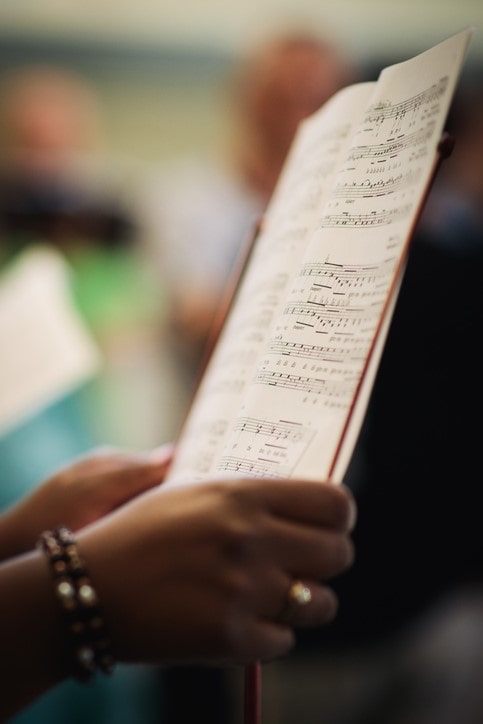NAfME BLOG
Speak the Language: Use Proper, Specific Musical Vocabulary in Your Daily Instruction

/ News Posts / Speak the Language: Use Proper, Specific Musical Vocabulary in Your Daily Instruction
Speak the Language
Use Proper, Specific Musical Vocabulary in Your Daily Instruction
By NAfME Member Lori Schwartz Reichl
This article was originally published in the March 2019 teacher edition of In Tune Magazine.
“The limits of my language are the limits of my world.” ~ Ludwig Wittgenstein
If we, as music educators, intend for our students to recognize, understand, demonstrate, and use proper musical vocabulary—in speaking and writing, in practice, rehearsal, and performance—then we must employ such vocabulary in our daily teaching. Simply asking students to memorize and regurgitate musical terms and definitions is not sufficient for retention and application. Reflect on your use of musical terms in the classroom and rehearsal space. When directing members of your ensemble in rehearsals to perform a particular scale in unison, are you utilizing the word concert prior to the scale’s name? If not, and you instruct the ensemble to perform the “A Major scale,” don’t be surprised if each musician performs the specific A Major scale, instead of the transposed scale if the instrument isn’t in concert pitch.
Also, are we using the Italian musical terms (or those in French, German, Latin, etc.), or are we instead using their English translations? For instance, when directing all members of the ensemble to sing or play, are you using the word tutti? Or are you just using such English vernacular as everyone or all? After a few uses of tutti while motioning with your arms for all members of the ensemble to perform, your students should respond accordingly. Are you instructing students to begin performing at the anacrusis to a certain measure? Or are you instead using the slang expression pick-up(s)? After a few persistent instances of replacing pick-up with anacrusis, your students should understand where to begin to sing or play within the notated music. They may even use anacrusis, a Greek and Modern Latin term, when asking a question about a musical phrase!
When directing an individual or section not to play or sing, are you using the designation tacet? Or are you instead saying, “Don’t play or sing”? Teach your students that the Latin word tacet means to be silent. When defining a crescendo, are you specifying that this dynamic marking means to gradually get louder? Or are you only stating to “get louder”? If you do not use this specific adverb, then your students might increase their volume immediately, rather than gradually.
In addition to this intentional use of language in the classroom, rehearsal, and performance setting, consider spending a few minutes in each lesson, sectional, or general rehearsal reviewing vocabulary with your students. If not each meeting, then every other day, or once a cycle or week. This can occur at all teaching levels, including elementary, middle, and high school or even at the collegiate level, appropriate for varying degrees of knowledge. You may be surprised which musical terms your students can or cannot make use of properly.
Younger musicians often struggle to categorize terms, let alone define and perform them. For instance, they may make the mistake of referring to andante as a dynamic marking, instead of a tempo marking. Mezzo forte may be mistakenly categorized as an articulation, rather than a dynamic marking.

Photo by Bob O’Lary
At the start of each marking period, performance season, or commencement of a new musical selection, separate the musical terms that you expect your students to know into categories. Here are some possible categories for improved comprehension and performance:
- Key Signatures
- Time Signatures
- Note Names/Values
- Styles
- Tempo Markings
- Dynamic Markings
- Articulations
- Ornamentations
- Signs/Symbols
- Other categories, such as pitches, rhythms, genres, composers, historical periods, etc.
Adjudication Vocabulary
As we prepare our ensembles for upcoming adjudications and performances, we must also discuss with our students the categories for which the ensemble’s performance will be evaluated. For example, in the state in which I teach, there are seven categories to be adjudicated:
- Tone
- Intonation
- Technique
- Balance
- Interpretation
- Musical Effect
- Other Factors
Continue to reflect on your use of musical language. How much time do you dedicate to preparing and discussing adjudication expectations with your students? To what extent have you examined these categories and their components with your students? Can your students define tone? Do they recognize common terms used to describe a particular instrument’s quality of sound? Regarding intonation, can your students decipher a melodic line and chordal structure? Can they acknowledge when their musical part is considered harmony or melody? When focusing on technique, can your students identify various articulations? Are your students aware of the pyramid of sound and how it relates to sectional and ensemble balance? Can your students identify and define all of the tempo markings appearing in your musical selections?
The excitement of earning a superior rating at an adjudication festival may cause conductors and musicians to ignore the characteristics of performance ratings. Have you inspected all possible ratings, explained their descriptions to your students, and reviewed all categories that calculate the performance’s final rating? Do your students understand the language to be used for evaluation, and are you using it with them on a daily basis?
“When we limit our use of musical vocabulary in our communication and instruction with our students, we limit their potential as musicians. So, speak the language and make it a daily habit.”
Proper musical vocabulary should be used from the onset of instruction by both musicians and educator. Speak this language at the start of each school year—don’t just cover it prior to an assessment, adjudication, or performance. When we limit our use of musical vocabulary in our communication and instruction with our students, we limit their potential as musicians. So, speak the language and make it a daily habit.
About the author:

Photo: Richard Twigg Photography
Lori Schwartz Reichl actively serves as an adjudicator, author, clinician, conductor, instructor, and speaker. Lori is the author of the “Tools for Educators” series entitled “Key Changes: Refreshing Your Music Program” published for InTune Monthly Magazine’s Teacher’s Edition, where she provides resources to enhance the music classroom and rehearsal space. Her column has been transformed into a summer graduate course that she instructs through the University of the Arts. Lori’s articles are also featured each month as part of the National Association for Music Education Music in a Minuet blog. In addition, her publications frequently appear in the Maryland Music Educator Journal and The Woman Conductor Journal. Lori also serves as a journalist for Teaching Music magazine and writes program notes for composers. In Maryland, she serves as artistic and executive director of the Regional Repertory Wind Ensemble, coordinator of Howard County’s Secondary Solo & Ensemble Festival, conductor of the Howard County Middle School Honor Band, and the Maryland state chair for Women Band Directors International. Visit her at MakingKeyChanges.com.
Did this blog spur new ideas for your music program? Share them on Amplify! Interested in reprinting this article? Please review the reprint guidelines.
The National Association for Music Education (NAfME) provides a number of forums for the sharing of information and opinion, including blogs and postings on our website, articles and columns in our magazines and journals, and postings to our Amplify member portal. Unless specifically noted, the views expressed in these media do not necessarily represent the policy or views of the Association, its officers, or its employees.
Catherina Hurlburt, Marketing Communications Manager. December 10, 2019. © National Association for Music Education (NAfME.org)
Published Date
December 10, 2019
Category
- Uncategorized
Copyright
December 10, 2019. © National Association for Music Education (NAfME.org)






